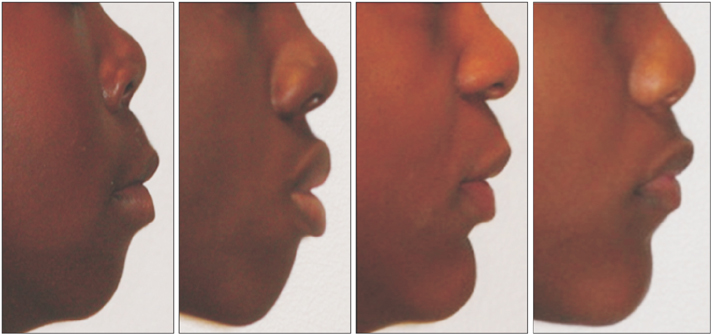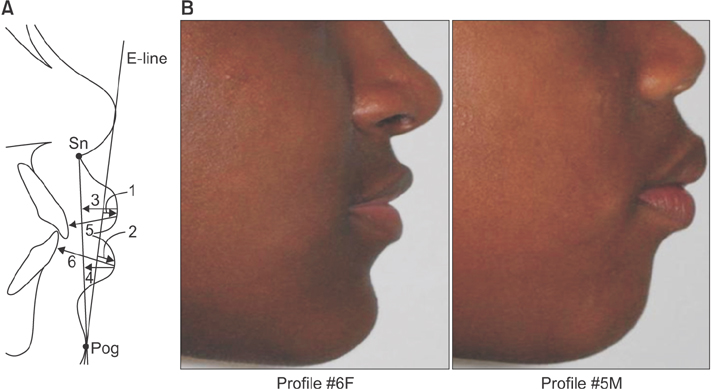Korean J Orthod.
2018 Jan;48(1):23-29. 10.4041/kjod.2018.48.1.23.
Disparity in opinions on lip protrusiveness in contemporary African American faces
- Affiliations
-
- 1Private Practice, Chicago, IL, USA.
- 2Department of Orthodontics and Pediatric Dentistry, School of Dentistry, University of Maryland, MD, USA. epae@umaryland.edu
- 3Department of Epidemiology and Biostatistics, School of Public Health, University of Maryland, MD, USA.
- KMID: 2441438
- DOI: http://doi.org/10.4041/kjod.2018.48.1.23
Abstract
OBJECTIVE
In accordance with the changing demographics in the United States, orthodontists working on various ethnic populations should be more conscious when using the standardized profile analyses for the African American patient. The objective of this study was to examine whether the perception of lip protrusiveness in modern African American faces has changed. For this purpose, we investigated the most favorable African American lip profile using the opinions of 10 experienced and 10 newly trained younger orthodontists.
METHODS
Attractiveness was converted to a number on visualized analog scales. Comparative ranks on 16 African American profiles, with focus on lip protrusiveness and thickness, were made among the groups. Mixed-effects linear regression models were fit and group differences were estimated.
RESULTS
Younger orthodontists favored a more protrusive lip profile, and the variance in their perceptions was narrower than those of older orthodontists. Measurements related to upper lip protrusion showed the strongest correlation to attractiveness (r = −0.82). The association with attractiveness decreased linearly as the protrusiveness of the upper lip increased. Steiner's E-line was the most influential reference for determining the level of attractiveness for the older orthodontists, whereas upper lip protrusion was the most influential factor for the young orthodontists.
CONCLUSIONS
An adequate level of lip protrusiveness and thickness should be essential for maintaining attractive esthetics in African American patients. Yet, a new set of standards for prominent lips in this population is necessary to reflect the current trend in the concept of a beautiful face in the modern world.
MeSH Terms
Figure
Reference
-
1. Drummond RA. A determination of cephalometric norms for the Negro race. Am J Orthod. 1968; 54:670–682.
Article2. Sushner NI. A photographic study of the soft-tissue profile of the Negro population. Am J Orthod. 1977; 72:373–385.
Article3. Enlow DH, Pfister C, Richardson E, Kuroda T. An analysis of Black and Caucasian craniofacial patterns. Angle Orthod. 1982; 52:279–287.4. Ricketts RM. Esthetics, environment, and the law of lip relation. Am J Orthod. 1968; 54:272–289.
Article5. Burstone CJ. Lip posture and its significance in treatment planning. Am J Orthod. 1967; 53:262–284.
Article6. Lavelle CL. Craniofacial profile angles in Caucasians and Negroes. J Dent. 1974; 2:160–166.7. Bailey KL, Taylor RW. Mesh diagram cephalometric norms for Americans of African descent. Am J Orthod Dentofacial Orthop. 1998; 114:218–223.
Article8. Hagler BL, Lupini J, Johnston LE Jr. Long-term comparison of extraction and nonextraction alternatives in matched samples of African American patients. Am J Orthod Dentofacial Orthop. 1998; 114:393–403.
Article9. Foster EJ. Profile preferences among diversified groups. Angle Orthod. 1973; 43:34–40.10. Huang WJ, Taylor RW, Dasanayake AP. Determining cephalometric norms for Caucasians and African Americans in Birmingham. Angle Orthod. 1998; 68:503–511. discussion 512.11. Richardson ER. Racial differences in dimensional traits of the human face. Angle Orthod. 1980; 50:301–311.12. Auger TA, Turley PK. The female soft tissue profile as presented in fashion magazines during the 1900s: a photographic analysis. Int J Adult Orthodon Orthognath Surg. 1999; 14:7–18.13. Yehezkel S, Turley PK. Changes in the African American female profile as depicted in fashion magazines during the 20th century. Am J Orthod Dentofacial Orthop. 2004; 125:407–417.
Article14. Nguyen DD, Turley PK. Changes in the Caucasian male facial profile as depicted in fashion magazines during the twentieth century. Am J Orthod Dentofacial Orthop. 1998; 114:208–217.
Article15. Sutter RE Jr, Turley PK. Soft tissue evaluation of contemporary Caucasian and African American female facial profiles. Angle Orthod. 1998; 68:487–496.16. Denize ES, McDonald F, Sherriff M, Naini FB. Facial profile parameters and their relative influence on bilabial prominence and the perceptions of facial profile attractiveness: a novel approach. Korean J Orthod. 2014; 44:184–194.
Article17. Hockley A, Weinstein M, Borislow AJ, Braitman LE. Photos vs silhouettes for evaluation of African American profile esthetics. Am J Orthod Dentofacial Orthop. 2012; 141:161–168.
Article18. Pithon MM, Silva IS, Almeida IO, Nery MS, de Souza ML, Barbosa G, et al. Photos vs silhouettes for evaluation of profile esthetics between white and black evaluators. Angle Orthod. 2014; 84:231–238.
Article19. Pae EK, McKenna GA, Sheehan TJ, Garcia R, Kuhlberg A, Nanda R. Role of lateral cephalograms in assessing severity and difficulty of orthodontic cases. Am J Orthod Dentofacial Orthop. 2001; 120:254–262.
Article20. Linear mixed-effects modeling in SPSS: an introduction to the MIXED procedure [Internet]. Chicago: SPSS Inc.;2005. cited 2017 Apr 1. Available from: http://www.spss.ch/upload/1126184451_Linear%20Mixed%20Effects%20Modeling%20in%20SPSS.pdf.21. Toureno L, Kook YA, Bayome M, Park JH. The effect of western adaptation of Hispanic-Americans on their assessment of Korean facial profiles. Korean J Orthod. 2014; 44:28–35.
Article22. McKoy-White J, Evans CA, Viana G, Anderson NK, Giddon DB. Facial profile preferences of black women before and after orthodontic treatment. Am J Orthod Dentofacial Orthop. 2006; 129:17–23.
Article23. Park YS, Evans CA, Viana G, Anderson NK, Giddon DB. Profile preferences of Korean American orthodontic patients and orthodontists. World J Orthod. 2006; 7:286–292.24. Majethia AP, Vadgaonkar VD, Deshpande KJ, Gangurde PV. Perception of aesthetics by different professionals of different communities. J Clin Diagn Res. 2015; 9:ZC18–ZC22.
Article
- Full Text Links
- Actions
-
Cited
- CITED
-
- Close
- Share
- Similar articles
-
- Normative anthropometry and proportions of the Kenyan-African face and comparative anthropometry in relation to African Americans and North American Whites
- Machine Learning to Compare Frequent Medical Problems of African American and Caucasian Diabetic Kidney Patients
- Fitness of Adjustable Dental Impression Trays on the Caucasian and African American
- Racial Disparity in Time to Surgery and Complications for Hip Fracture Patients
- End-of-Life Planning and the Influence of Socioeconomic Status among Black Americans: A Systematic Review




